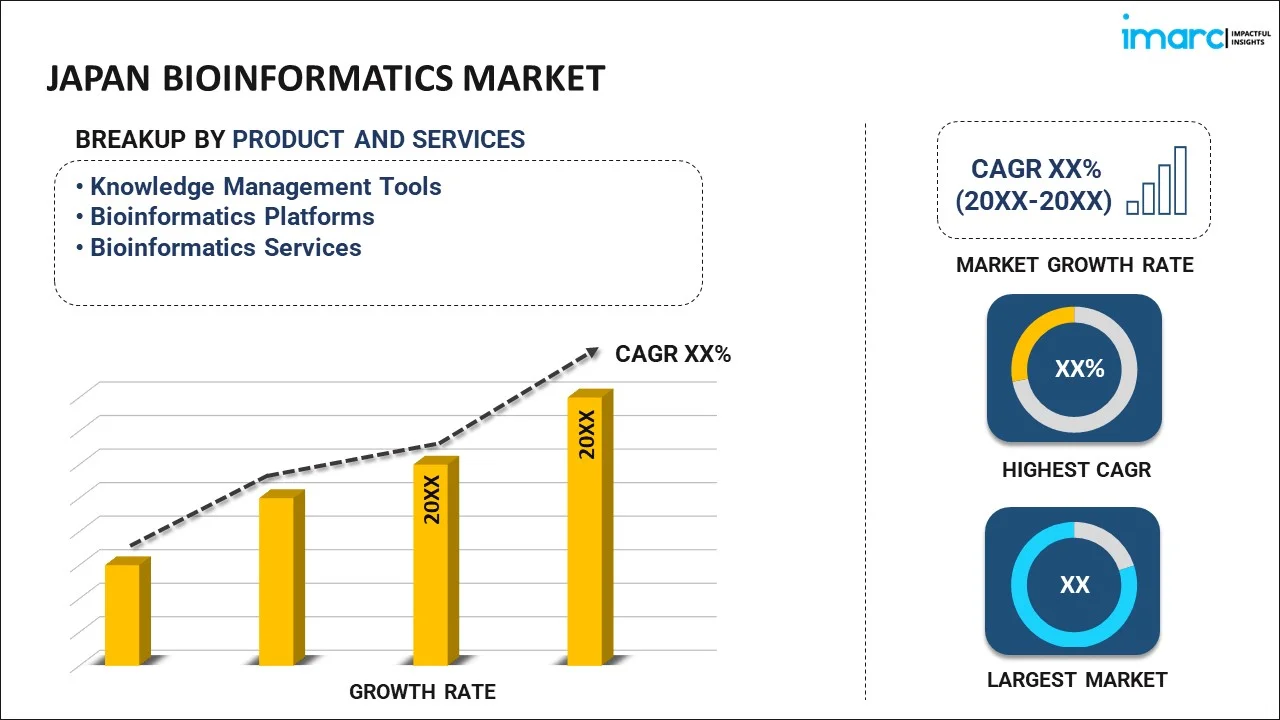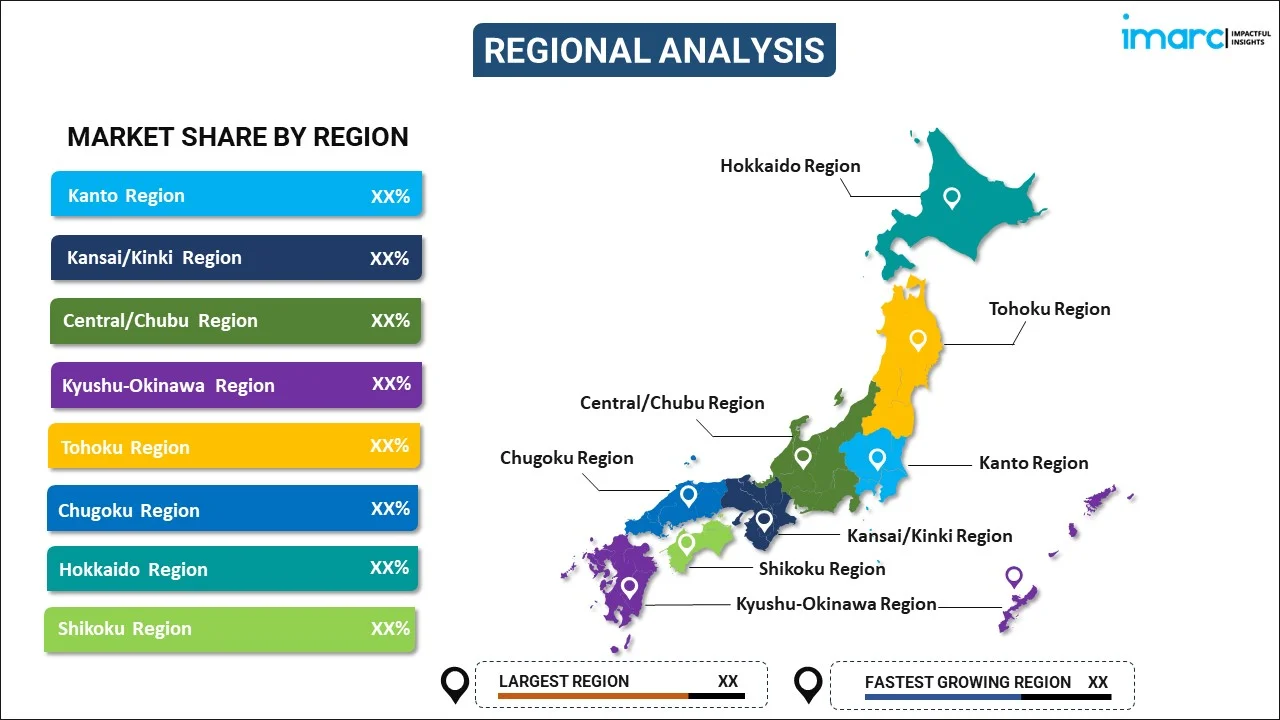
Japan Bioinformatics Market Report by Product and Service (Knowledge Management Tools, Bioinformatics Platforms, Bioinformatics Services), Application (Genomics, Chemoinformatics and Drug Design, Proteomics, Transcriptomics, Metabolomics, and Others), End Use Sector (Medical Biotechnology, Academics, Animal Biotechnology, Agricultural Biotechnology, Environmental Biotechnology, Forensic Biotechnology, and Others), and Region 2025-2033
Market Overview:
Japan bioinformatics market size reached USD 625.5 Million in 2024. Looking forward, IMARC Group expects the market to reach USD 2,491.8 Million by 2033, exhibiting a growth rate (CAGR) of 15.3% during 2025-2033. The market is being driven by major factors, such as progress in genomic research, notable breakthroughs and progress in pharmaceuticals, an increasing incidence of chronic illnesses, and rapid technological advancements.
|
Report Attribute
|
Key Statistics
|
|---|---|
|
Base Year
|
2024
|
|
Forecast Years
|
2025-2033
|
|
Historical Years
|
2019-2024
|
| Market Size in 2024 | USD 625.5 Million |
| Market Forecast in 2033 | USD 2,491.8 Million |
| Market Growth Rate 2025-2033 | 15.3% |
Bioinformatics is a multidisciplinary domain that integrates biology, computer science, and statistics to derive valuable insights and understanding from extensive biological datasets. It encompasses the utilization of computational methods and algorithms to scrutinize and elucidate biological data, including DNA sequences, protein configurations, and gene expression data. Bioinformatics serves as a fundamental component in numerous facets of contemporary life sciences, encompassing genomics, proteomics, and the exploration of novel drugs. A key role of bioinformatics is to assist scientists in unraveling the genetic code and comprehending the intricate associations among genes and their functionalities.
Japan Bioinformatics Market Trends:
The bioinformatics market in Japan is a thriving and dynamic sector at the intersection of biology, computer science, and statistics. Several factors contribute to the growth and significance of the bioinformatics market in Japan. Firstly, Japan boasts a robust ecosystem of research institutions, universities, and pharmaceutical companies that actively engage in genomics, proteomics, and drug discovery. This collaborative environment fosters innovation and drives the demand for bioinformatics solutions. Secondly, the rising prevalence of chronic diseases in Japan has heightened the importance of bioinformatics in deciphering complex genetic factors contributing to these conditions. Researchers and healthcare professionals increasingly rely on bioinformatics tools to gain insights into disease mechanisms, paving the way for personalized medicine and targeted therapies. Furthermore, the Japanese government's stringent initiatives and substantial funding in the field of life sciences and biotechnology have propelled advancements in bioinformatics. These initiatives promote research, development, and adoption of cutting-edge bioinformatics technologies. Japan's bioinformatics market is also benefiting from rapid technological advancements in high-throughput sequencing, data analysis, and cloud computing, enabling researchers to efficiently manage and analyze vast biological datasets. In conclusion, the Japan bioinformatics market is poised for continuous growth due to its strong research ecosystem, the prevalence of chronic diseases, government support, and ongoing technological progress. These factors collectively are anticipated to fuel the regional market in the coming years.
Japan Bioinformatics Market Segmentation:
IMARC Group provides an analysis of the key trends in each segment of the market, along with forecasts at the country level for 2025-2033. Our report has categorized the market based on product and service, application, and end use sector.
Product and Service Insights:

- Knowledge Management Tools
- Generalized Knowledge Management Tools
- Specialized Knowledge Management Tools
- Bioinformatics Platforms
- Surgical Simulation Platforms
- Sequence Analysis, Alignment and Manipulation Platforms
- Structural and Functional Analysis Platforms
- Others
- Bioinformatics Services
- Data Analysis Services
- Database Management Services
- Others
The report has provided a detailed breakup and analysis of the market based on the product and service. This includes knowledge management tools (generalized knowledge management tools and specialized knowledge management tools), bioinformatics platforms (surgical simulation platforms, sequence analysis, alignment and manipulation platforms, structural and functional analysis platforms, and others), and bioinformatics services (data analysis services, database management services, and others).
Application Insights:
- Genomics
- Chemoinformatics and Drug Design
- Proteomics
- Transcriptomics
- Metabolomics
- Others
A detailed breakup and analysis of the market based on the application have also been provided in the report. This includes genomics, chemoinformatics and drug design, proteomics, transcriptomics, metabolomics, and others.
End Use Sector Insights:
- Medical Biotechnology
- Academics
- Animal Biotechnology
- Agricultural Biotechnology
- Environmental Biotechnology
- Forensic Biotechnology
- Others
The report has provided a detailed breakup and analysis of the market based on the end use sector. This includes medical biotechnology, academics, animal biotechnology, agricultural biotechnology, environmental biotechnology, forensic biotechnology, and others.
Regional Insights:

- Kanto Region
- Kansai/Kinki Region
- Central/ Chubu Region
- Kyushu-Okinawa Region
- Tohoku Region
- Chugoku Region
- Hokkaido Region
- Shikoku Region
The report has also provided a comprehensive analysis of all the major regional markets, which include Kanto Region, Kansai/Kinki Region, Central/ Chubu Region, Kyushu-Okinawa Region, Tohoku Region, Chugoku Region, Hokkaido Region, and Shikoku Region.
Competitive Landscape:
The market research report has also provided a comprehensive analysis of the competitive landscape. Competitive analysis such as market structure, key player positioning, top winning strategies, competitive dashboard, and company evaluation quadrant has been covered in the report. Also, detailed profiles of all major companies have been provided.
Japan Bioinformatics Market Report Coverage:
| Report Features | Details |
|---|---|
| Base Year of the Analysis | 2024 |
| Historical Period | 2019-2024 |
| Forecast Period | 2025-2033 |
| Units | Million USD |
| Scope of the Report | Exploration of Historical Trends and Market Outlook, Industry Catalysts and Challenges, Segment-Wise Historical and Future Market Assessment:
|
| Product and Services Covered |
|
| Applications Covered | Genomics, Chemoinformatics and Drug Design, Proteomics, Transcriptomics, Metabolomics, Others |
| End Use Sectors Covered | Medical Biotechnology, Academics, Animal Biotechnology, Agricultural Biotechnology, Environmental Biotechnology, Forensic Biotechnology, Others |
| Regions Covered | Kanto Region, Kansai/Kinki Region, Central/ Chubu Region, Kyushu-Okinawa Region, Tohoku Region, Chugoku Region, Hokkaido Region, Shikoku Region |
| Customization Scope | 10% Free Customization |
| Post-Sale Analyst Support | 10-12 Weeks |
| Delivery Format | PDF and Excel through Email (We can also provide the editable version of the report in PPT/Word format on special request) |
Key Questions Answered in This Report:
- How has the Japan bioinformatics market performed so far and how will it perform in the coming years?
- What has been the impact of COVID-19 on the Japan bioinformatics market?
- What is the breakup of the Japan bioinformatics market on the basis of product and service?
- What is the breakup of the Japan bioinformatics market on the basis of application?
- What is the breakup of the Japan bioinformatics market on the basis of end use sector?
- What are the various stages in the value chain of the Japan bioinformatics market?
- What are the key driving factors and challenges in the Japan bioinformatics?
- What is the structure of the Japan bioinformatics market and who are the key players?
- What is the degree of competition in the Japan bioinformatics market?
Key Benefits for Stakeholders:
- IMARC’s industry report offers a comprehensive quantitative analysis of various market segments, historical and current market trends, market forecasts, and dynamics of the Japan bioinformatics market from 2019-2033.
- The research report provides the latest information on the market drivers, challenges, and opportunities in the Japan bioinformatics market.
- Porter's five forces analysis assist stakeholders in assessing the impact of new entrants, competitive rivalry, supplier power, buyer power, and the threat of substitution. It helps stakeholders to analyze the level of competition within the Japan bioinformatics industry and its attractiveness.
- Competitive landscape allows stakeholders to understand their competitive environment and provides an insight into the current positions of key players in the market.
Need more help?
- Speak to our experienced analysts for insights on the current market scenarios.
- Include additional segments and countries to customize the report as per your requirement.
- Gain an unparalleled competitive advantage in your domain by understanding how to utilize the report and positively impacting your operations and revenue.
- For further assistance, please connect with our analysts.
 Inquire Before Buying
Inquire Before Buying
 Speak to an Analyst
Speak to an Analyst
 Request Brochure
Request Brochure
 Request Customization
Request Customization




.webp)




.webp)












